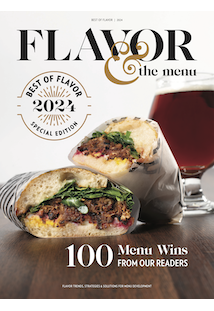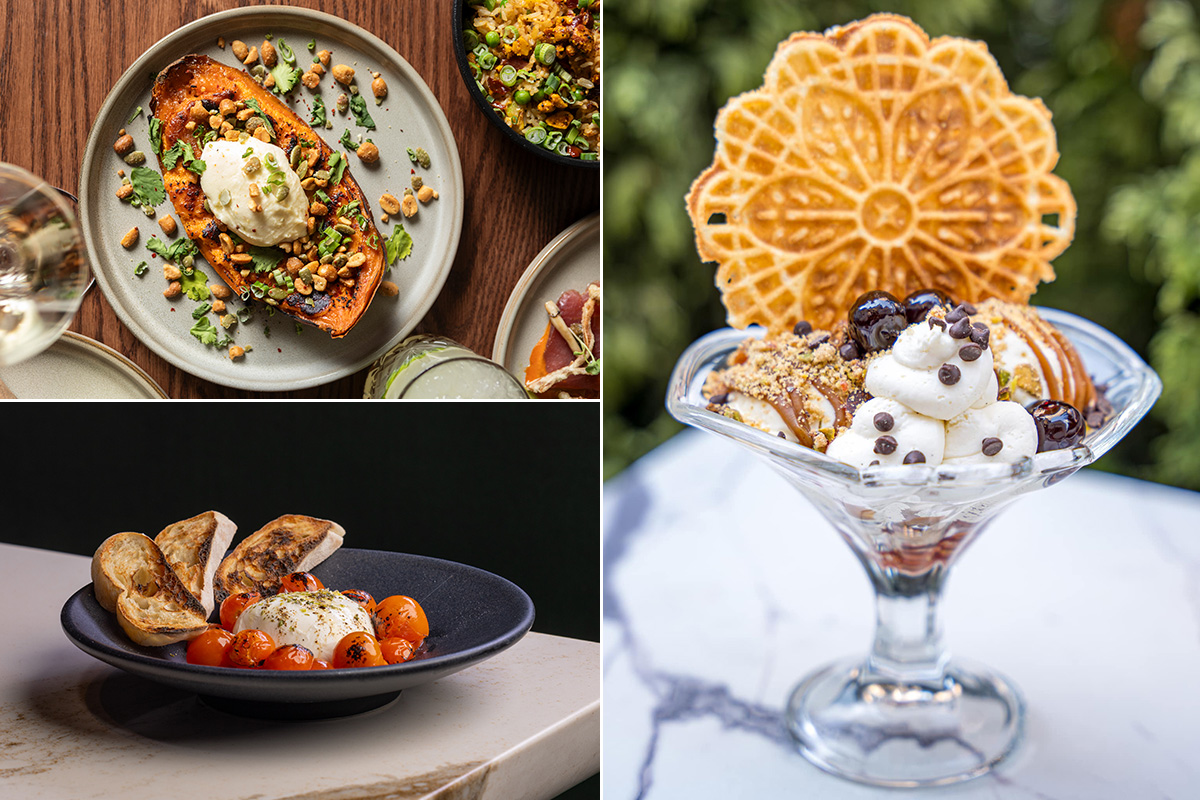
The Delicious Drama of Cheese
Taking dishes from standard to showstopping
The Delicious Drama of Cheese
Taking dishes from standard to showstopping
By Leigh Kunkel
May 16, 2024
By Leigh Kunkel
May 16, 2024
Few ingredients can match the “Wow!” factor of cheese: from buttery and spreadable to sharp and shredded; pale gold to bright orange to ashy blue veined; craggy and crumbled to melted and glossy. Indeed, cheese can punch up any menu item—and regularly steals the show from the main ingredient. In addition to its complex flavor profile, cheese can also be a visual feast, as demonstrated by millions of social media photos and the internet’s collective obsession over #cheesepull compilations.
This versatility also makes cheese the perfect ingredient for taking dishes to the next level. Borrow some inspiration from restaurants and chefs who are finding fresh ways to put cheese front-and-center, making their menus all the more irresistible.
Embrace Global Varieties
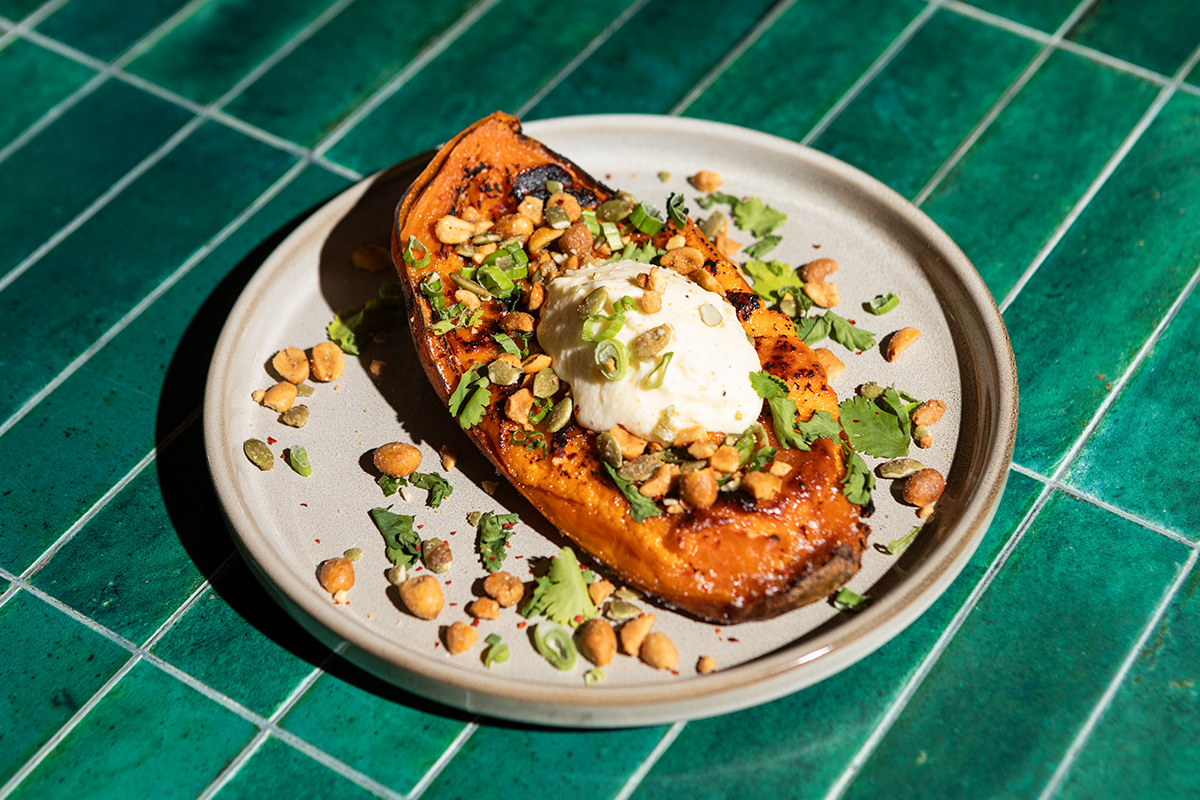 Photo Credit: Garrett Baumer
Photo Credit: Garrett Baumer At Brasero, the Coal-Roasted Sweet Potato isn’t too sweet, thanks to the mild, slightly salted flavor of catupiry cheese.
Since opening in February, South American-inspired, live-fire restaurant Brasero in Chicago has had an unexpected star of the show: the Coal-Roasted Sweet Potato stuffed and topped with catupiry, a creamy, mild Brazilian cheese.
The dish came about when Chef/Owner John Manion asked Melody Arnold, his sous, to come up with a sweet potato dish for the menu. Having grown up in the American South, where sweet potatoes are often served with brown sugar or marshmallows, Arnold knew she didn’t want to build another overly sweet dish. She saw an Instagram reel of a brûléed sweet potato served as dessert and began thinking about how to create a savory version. When Manion brought a jar of catupiry in for the team to taste, the mild, lightly salted flavor sparked something. “The minute I tried it, I said, ‘This is perfect,’” Arnold recalls. “Before we added cheese, the sweet potato was too sweet, so I incorporated more and more cheese until it was about a 50/50 mix of potato and cheese.” Now the restaurant makes its own catupiry in-house.
To make the dish, Arnold roasts the foil-wrapped sweet potato in the coals of the live-fire hearth and then scoops out the filling to combine with the catupiry, honey and house-fermented hot sauce. It’s then piped back into the shell, brûléed, topped with even more catupiry so it’s extra gooey, then garnished with fried peanuts, pepitas and herbs.
The dish has been the No. 1 seller since the restaurant opened, and, per Arnold, the team has never heard a single negative comment about it.
“Everyone always says, ‘How did you get the sweet potato to taste like this?’” she says. “It’s the cheese. It’s always the cheese.”
Catupiry is also featured in Brasero’s pão de queijo, a traditional Brazilian bread made with Parmesan and baked into balls. When blended with herbs, catupiry makes the perfect dip for the pão de queijo and doubles the cheese factor.
Try a New Technique
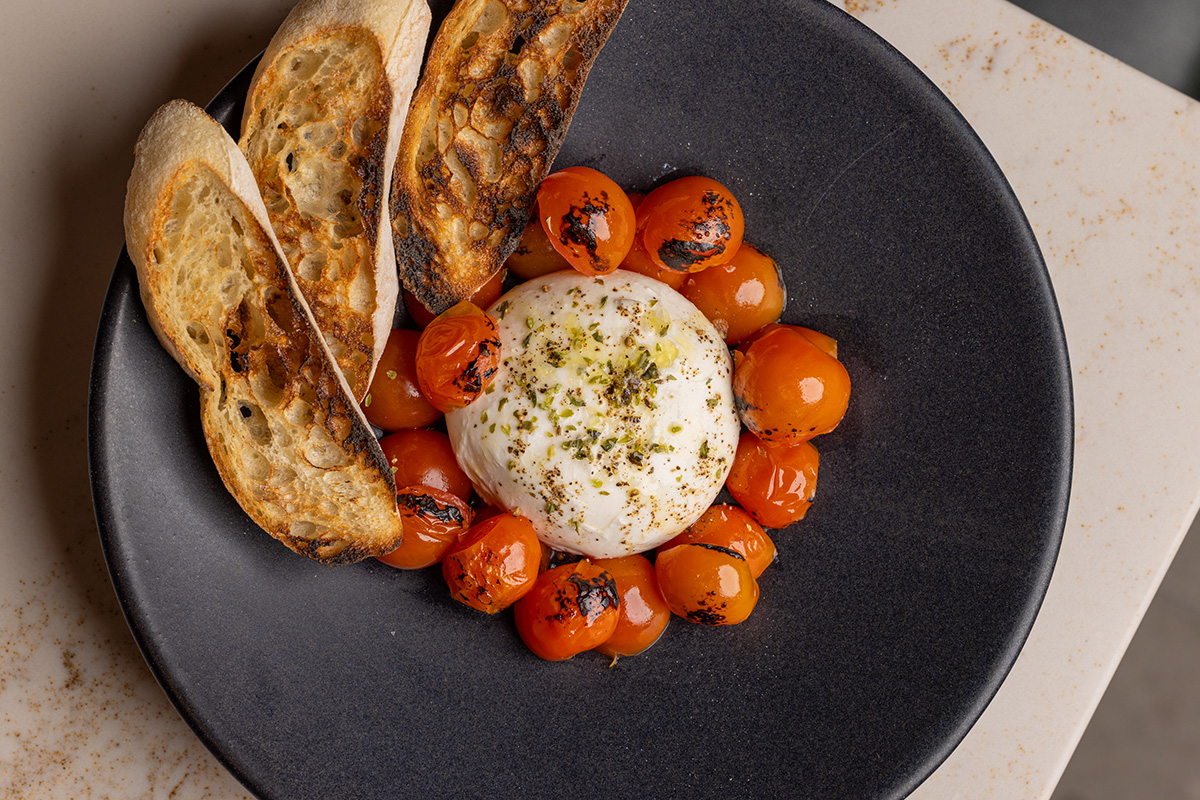 Photo Credit: The Amalfi Llama
Photo Credit: The Amalfi Llama The Amalfi Llama roasts its burrata in the pizza oven to deepen the flavor and make it extra pliant for spreading over housemade focaccia.
Burrata—those decadent pouches of mozzarella and stracciatella bursting with rich flavor—is a common sight on Italian menus. To take the traditional dish to the next level, the chefs at The Amalfi Llama, with locations in Miami and San Diego, employed a surprising tool in the preparation: the pizza oven.
“Our chefs collaborated to brainstorm ways of innovating classic dishes, which led us to experiment with different cooking techniques and flavor pairings,” says Jaime Chavez, head chef of the San Diego outpost. The result? Fresh burrata, delicately roasted over a cedar plank in the pizza oven, then served with blistered tomatoes and housemade focaccia.
Roasting the burrata not only infuses it with flavor but also softens the texture, making it perfect for spreading onto the fluffy focaccia. The bright, tangy notes of the roasted tomatoes contrast the luscious, umami-packed burrata, leading customers to describe the dish as a delightful balance of creamy richness and vibrant flavors.
Burrata isn’t the only cheesy star at The Amalfi Llama. “We rely on a variety of cheeses to elevate different dishes,” Chavez says. “We use fior di latte for our Margherita pizza, Caciocavallo for other pizza variations and a blend of mascarpone and brie for our Basque cheesecake. Each cheese brings its unique character to our menu offerings, enhancing the overall dining experience.”
Play With Format and Flavor
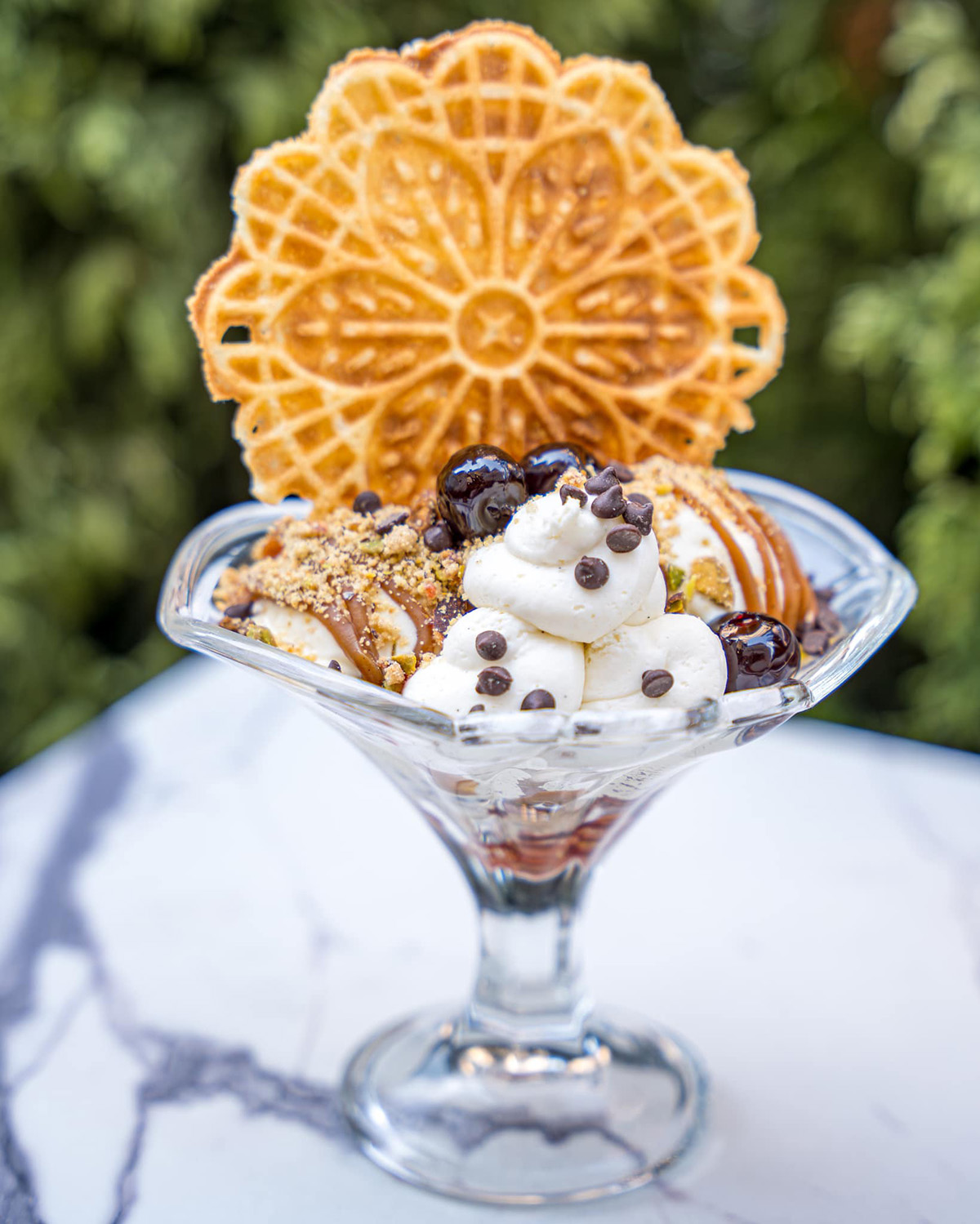 Photo Credit: Ophelia’s Pizza + Bar
Photo Credit: Ophelia’s Pizza + Bar Ophelia’s Pizza + Bar takes the ricotta out of the cannoli and turns it into a fluffy ice cream garnished with amarena cherries, chocolate chips, pistachios and a pizzelle.
The culinary range of cheese offers chefs the freedom to turn traditional recipes on their head through one-of-a-kind creations. With cheese, menu developers can use the same ingredient and come up with completely different dishes.
Take ricotta as an example. At Ophelia’s Pizza + Bar in Nashville, Tenn., the Cannoli Sundae turns the classic Italian dessert inside out; creamy ricotta ice cream is topped with amarena cherries, chocolate chips and pistachios, while a housemade pizzelle serves as an accent piece rather than a carrier for the ricotta. In Washington, D.C., Opal also flouts the typical rules of ricotta, bringing bucolic vibes to ravioli in the form of its ricotta dumplings, made with brown butter, English peas and fiddlehead ferns.
As global cuisines continue to take root, menu developers will have even more cheese varieties and flavor systems at their disposal. Zou Zou’s in New York City heats up both the temperature and the spice level of its kasseri, a sheep’s milk cheese from Greece. The cheese is served with candied pumpkin seeds and Aleppo chile flakes and set aflame tableside to create a golden crust.
But even when cheese-centric dishes aren’t quite that dramatic, they’re guaranteed to liven up the menu. So whether you’re setting it on fire, toasting it in the oven or whipping it up into a cloud, cheese offers endless ways to take a dish from standard to showstopping.
Few ingredients can match the “Wow!” factor of cheese: from buttery and spreadable to sharp and shredded; pale gold to bright orange to ashy blue veined; craggy and crumbled to melted and glossy. Indeed, cheese can punch up any menu item—and regularly steals the show from the main ingredient. In addition to its complex flavor profile, cheese can also be a visual feast, as demonstrated by millions of social media photos and the internet’s collective obsession over #cheesepull compilations.
This versatility also makes cheese the perfect ingredient for taking dishes to the next level. Borrow some inspiration from restaurants and chefs who are finding fresh ways to put cheese front-and-center, making their menus all the more irresistible.
Embrace Global Varieties
 Photo Credit: Garrett Baumer
Photo Credit: Garrett Baumer At Brasero, the Coal-Roasted Sweet Potato isn’t too sweet, thanks to the mild, slightly salted flavor of catupiry cheese.
Since opening in February, South American-inspired, live-fire restaurant Brasero in Chicago has had an unexpected star of the show: the Coal-Roasted Sweet Potato stuffed and topped with catupiry, a creamy, mild Brazilian cheese.
The dish came about when Chef/Owner John Manion asked Melody Arnold, his sous, to come up with a sweet potato dish for the menu. Having grown up in the American South, where sweet potatoes are often served with brown sugar or marshmallows, Arnold knew she didn’t want to build another overly sweet dish. She saw an Instagram reel of a brûléed sweet potato served as dessert and began thinking about how to create a savory version. When Manion brought a jar of catupiry in for the team to taste, the mild, lightly salted flavor sparked something. “The minute I tried it, I said, ‘This is perfect,’” Arnold recalls. “Before we added cheese, the sweet potato was too sweet, so I incorporated more and more cheese until it was about a 50/50 mix of potato and cheese.” Now the restaurant makes its own catupiry in-house.
To make the dish, Arnold roasts the foil-wrapped sweet potato in the coals of the live-fire hearth and then scoops out the filling to combine with the catupiry, honey and house-fermented hot sauce. It’s then piped back into the shell, brûléed, topped with even more catupiry so it’s extra gooey, then garnished with fried peanuts, pepitas and herbs.
The dish has been the No. 1 seller since the restaurant opened, and, per Arnold, the team has never heard a single negative comment about it.
“Everyone always says, ‘How did you get the sweet potato to taste like this?’” she says. “It’s the cheese. It’s always the cheese.”
Catupiry is also featured in Brasero’s pão de queijo, a traditional Brazilian bread made with Parmesan and baked into balls. When blended with herbs, catupiry makes the perfect dip for the pão de queijo and doubles the cheese factor.
Try a New Technique
 Photo Credit: The Amalfi Llama
Photo Credit: The Amalfi Llama The Amalfi Llama roasts its burrata in the pizza oven to deepen the flavor and make it extra pliant for spreading over housemade focaccia.
Burrata—those decadent pouches of mozzarella and stracciatella bursting with rich flavor—is a common sight on Italian menus. To take the traditional dish to the next level, the chefs at The Amalfi Llama, with locations in Miami and San Diego, employed a surprising tool in the preparation: the pizza oven.
“Our chefs collaborated to brainstorm ways of innovating classic dishes, which led us to experiment with different cooking techniques and flavor pairings,” says Jaime Chavez, head chef of the San Diego outpost. The result? Fresh burrata, delicately roasted over a cedar plank in the pizza oven, then served with blistered tomatoes and housemade focaccia.
Roasting the burrata not only infuses it with flavor but also softens the texture, making it perfect for spreading onto the fluffy focaccia. The bright, tangy notes of the roasted tomatoes contrast the luscious, umami-packed burrata, leading customers to describe the dish as a delightful balance of creamy richness and vibrant flavors.
Burrata isn’t the only cheesy star at The Amalfi Llama. “We rely on a variety of cheeses to elevate different dishes,” Chavez says. “We use fior di latte for our Margherita pizza, Caciocavallo for other pizza variations and a blend of mascarpone and brie for our Basque cheesecake. Each cheese brings its unique character to our menu offerings, enhancing the overall dining experience.”
Play With Format and Flavor
 Photo Credit: Ophelia’s Pizza + Bar
Photo Credit: Ophelia’s Pizza + Bar Ophelia’s Pizza + Bar takes the ricotta out of the cannoli and turns it into a fluffy ice cream garnished with amarena cherries, chocolate chips, pistachios and a pizzelle.
The culinary range of cheese offers chefs the freedom to turn traditional recipes on their head through one-of-a-kind creations. With cheese, menu developers can use the same ingredient and come up with completely different dishes.
Take ricotta as an example. At Ophelia’s Pizza + Bar in Nashville, Tenn., the Cannoli Sundae turns the classic Italian dessert inside out; creamy ricotta ice cream is topped with amarena cherries, chocolate chips and pistachios, while a housemade pizzelle serves as an accent piece rather than a carrier for the ricotta. In Washington, D.C., Opal also flouts the typical rules of ricotta, bringing bucolic vibes to ravioli in the form of its ricotta dumplings, made with brown butter, English peas and fiddlehead ferns.
As global cuisines continue to take root, menu developers will have even more cheese varieties and flavor systems at their disposal. Zou Zou’s in New York City heats up both the temperature and the spice level of its kasseri, a sheep’s milk cheese from Greece. The cheese is served with candied pumpkin seeds and Aleppo chile flakes and set aflame tableside to create a golden crust.
But even when cheese-centric dishes aren’t quite that dramatic, they’re guaranteed to liven up the menu. So whether you’re setting it on fire, toasting it in the oven or whipping it up into a cloud, cheese offers endless ways to take a dish from standard to showstopping.
About the Author
![]() Leigh Kunkel is a freelance journalist with more than a decade of restaurant industry experience as a server, bartender and sommelier. She has written about restaurant operations for B2B publications, as well as foodservice brands, including Beam Suntory and Dawn Foods. She specializes in covering flavor, ingredient and cuisine trends. Leigh has also covered the food and beverage world for a wide range of consumer outlets such as The New York Times, Eater and Vinepair.
Leigh Kunkel is a freelance journalist with more than a decade of restaurant industry experience as a server, bartender and sommelier. She has written about restaurant operations for B2B publications, as well as foodservice brands, including Beam Suntory and Dawn Foods. She specializes in covering flavor, ingredient and cuisine trends. Leigh has also covered the food and beverage world for a wide range of consumer outlets such as The New York Times, Eater and Vinepair.

